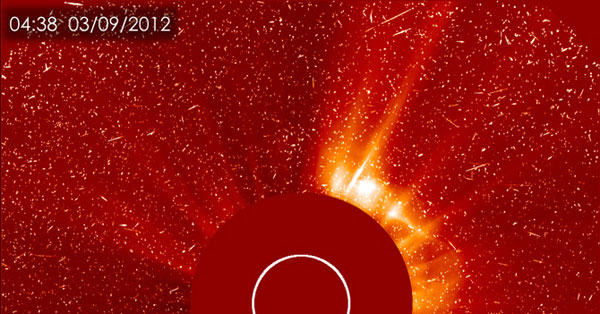
Above, one of a number of images released by NASA today that show how a coronal mass ejection (or CME) from our Sun progressed on March 8, 11:38 PM EST to March 9, 12:53 AM EST. These were captured by the Solar Heliospheric Observatory (SOHO).
Snip from NASA:
The sun is obscured in this image, called a coronograph, so that the dim atmosphere — or corona — around the sun can be better seen. The white speckles on the image are “noise” from solar particles hitting the instrument. On March 8, 2012 at 10:53 PM EST it erupted with an M6.3 class flare, and about an hour later released a CME. In addition to today’s rising geomagnetic storm conditions, active region 1429 that has so far produced two X class flares, and numerous M-class flares continues to crackle. NASA’s Space Weather Center models measure the CME traveling at speeds of over 700 miles per second. The CME should reach Earth’s magnetosphere, the protective envelope of magnetic fields around the planet, early in the morning of March 11.
So, there you have it. Sometime in the AM on Sunday, you and everyone you love and all that is beautiful in the world will crackle in flames and ash, then end in a fiery death. (Just kidding!)
Bill Harwood, space consultant for CBS News (one of the truly great science reporters of our time), explains what it all means:
The sun goes through an 11-year cycle, and solar flares, as its tending toward maximum, which the sun is doing right now, are not unusual. These aren’t the biggest flares they’ve ever seen, but they are the most energetic in the last five years or so. There probably will be some good auroral displays, the northern and southern lights, if you will. There could be some disruptions. There could also be some impact on global positioning system readings.
And a special note for communications DIYers: For more on how the solar event affects amateur (“ham”) radio operations, ARRL has this update today. If you’re into that sort of thing, you may want to follow the @solarham account on Twitter, too.